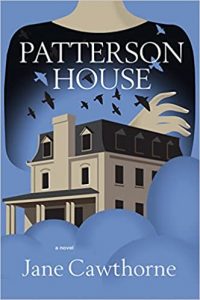Readers Teach Me About My Novel Patterson House
 Readers Teach Me About My Novel Patterson House
Readers Teach Me About My Novel Patterson House
I’ve dreamed of talking about my historical novel, Patterson House, with actual readers for years and now that it is in bookstores, I finally have the opportunity. I love the process of letting the work go into the world and seeing what it will become in the hands of readers. And I love what I learn about my work from them.
Discussing Patterson House with readers has felt fun and gossipy in a completely harmless way because everyone is fictional. It has also been a bit of a relief after having kept this huge cast of characters to myself for so long. Readers surprise me by sometimes talking in detail about minor characters, like the butcher’s wife, and say things like, “I know someone just like her!” When they talk to me about Alden, one of the two main characters, the most common thing they say is, “I can’t believe she did THAT!”
I’m one of those writers who doesn’t do a lot of outlining. As a result, much of what happens as I write is a genuine surprise to me too, and I tell them so. Alden is a woman trying to retain her independence in a time that does not allow for it. She is full of contradictions—a complex character who makes a lot of mistakes—which is something many of us can relate to. I was concerned readers would dislike her, but that has not been the case. One reader even called her “magnificently unapologetic.” I treasure that description.
The other main character in Patterson House is Constance. Alden finds her abandoned as a baby and brings her back to Patterson House with her. Originally, Constance had been my only main character. My original title for the novel was even, “Constance.” But from the time Alden entered the narrative, she demanded a more central role, and they became two main characters. It is easy for Alden to steal the limelight from the much younger and more tentative Constance.
Readers have brought to my attention that I have not been highlighting Constance enough. The event coordinator at one bookstore where I read during my book tour took the focus of the story away from Alden completely and put it right on Constance, describing the novel as “a queer coming of age story.” When I saw her promotional materials, I was taken aback for a second, and then I was grateful. Patterson House is Constance’s story as much as Alden’s, and it IS a queer coming of age story. But I had neglected this important part of the story in promoting the work.
I recognize how this happened. For one thing, Constance is a baby until part two, and in readings, I tend not to want to go too deep in the book or give any spoilers. Secondly, it is hard to speak briefly about a multi-generational family tale with so many characters. When it came time to write a synopsis of Patterson House for my publisher, I joked that it was harder than writing the novel. I don’t think I’m the only author who has felt this way. Once again, the formidable character of Alden took centre stage. I landed on a few sentences that focus on Alden as the last remaining Patterson living in the decaying family home with Constance and Mr. Hunt and alluded to her grandfather whose notorious suicide taints the family name. I suggested the main conflict, which is not between Alden and Constance, but with a new and mysterious boarder. The focus made sense because it is where the novel starts. But I ended up giving short shrift to Constance and the importance of her part of the narrative.
It’s too late to do the tour over, but if I could, I would make sure I always read something from deeper in the novel about Constance. Readers will always tell you what your work is about. You can depend on them for that. They have clarity that sometimes eludes the author after spending so much time immersed in the story. And I’m fairly certain this is just one of many things readers will teach me about Patterson House.
—
Jane Cawthorne writes about women in moments of crises and transformation. Her short stories and essays have appeared in newspapers, magazines, literary journals, scholarly journals and anthologies. She has edited two anthologies with E.D. Morin, Impact: Women Writing After Concussion, which won the Book Publisher Association of Alberta’s prize for Trade Non-Fiction Book of the Year, and Writing Menopause. Her debut novel, Patterson House, is set in Toronto, her birthplace, and a city dear to her even when she lives elsewhere. Jane spent decades active in the pro-choice and reproductive justice movement and is a former Women’s Studies instructor as well as a former high school and middle school teacher. She has an MFA in Creative Writing from the Solstice Program in Boston, MA. She lives in Victoria. BC. www.janecawthorne.com
Twitter: @Other_Jane
Instagram: @Other-Jane
Mastodon: @OtherJane@zeroes.ca
PATTERSON HOUSE
Part historical novel, part feminist rally cry.
 Tainted by the suicide of her long dead and scandal plagued grandfather, Alden Patterson wants two things: to regain what she sees as her rightful place in Toronto society and to do so without succumbing to the traditional role of wife and mother. But escaping such roles is almost impossible for a woman in 1916 and the history of the Patterson family and Patterson House haunts her.
Tainted by the suicide of her long dead and scandal plagued grandfather, Alden Patterson wants two things: to regain what she sees as her rightful place in Toronto society and to do so without succumbing to the traditional role of wife and mother. But escaping such roles is almost impossible for a woman in 1916 and the history of the Patterson family and Patterson House haunts her.
On the day she imagines her most ambitious plans will come to fruition, Alden unexpectedly becomes guardian to a foundling, Constance. Alden’s dreams are further dashed when her father dies in the Spanish Flu epidemic and she learns that the family money is gone. Aided by a former member of the household staff and returning veteran, the horribly disfigured John Hunt, Alden takes in boarders to support this unlikely trio. When a mysterious new boarder, Carling Grant, arrives, Alden thinks he will save her, but his presence, the divisions he creates, and the secret he reveals puts everything Alden has at risk–her house, her identity, John Hunt, and even Constance.
“Part sweeping historical novel, part ghost story, part coming of age tale and part feminist rally cry, PATTERSON HOUSE is a novel that manages to do so much at once. I loved the close examination of Toronto’s history and the reality of women’s limited options in the early 1900s. Alden Patterson is a fictional hero for our times, a woman trying hard to retain her independence in an era that doesn’t allow for it. Cawthorne’s writing is fluid and spare, allowing the novel’s twists and turns to guide the reader. This is a wonderful book.”–Amy Stuart, author of Still Mine
“One of the numerous delights of this first novel is the picture it presents of Toronto at the turn of the twentieth century and into the 1930s. But it is Toronto as lived in by women: the unwed mothers, the motherless girls, the women who have given up their rights when they marry only to discover how bad the bargain they have made is, and also, but certainly not the least, those brave ones who defy convention and refuse the life laid out for them. Salvation for women is hard to come by in this writerly world, but it sometimes does through dogged persistence, mutual support, simple courage, and once in a while, through plain dumb luck. Jane Cawthorne’s PATTERSON HOUSE is a tightly-woven, warm and lively novel that builds in tension in such a way that nearing the end, the reader won’t be able to put the book down.”–Sharon Butala
“The PATTERSON HOUSE saga is old-fashioned in all the right ways: a great broad canvas of time and event; multiple characters with deeply complicated desires and obstacles; and maybe best of all, writing that is both muscular and lyrical. PBS, are you reading?”–Sandra Scofield, author of six novels, including the National Book Award finalist Beyond Deserving
Fiction. Women’s Studdies.
BUY HERE
Category: On Writing























